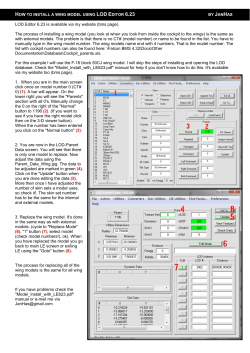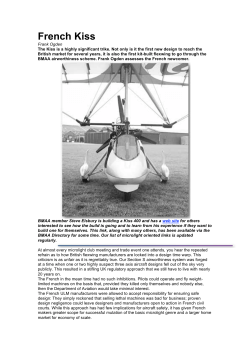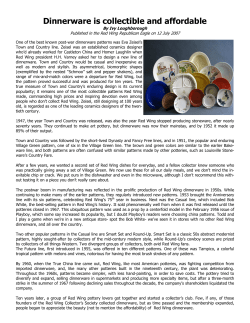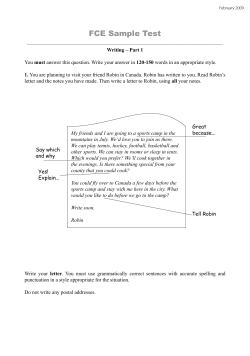
FLYING TIkaL RUINS THE + EIGHT
PM APRIL - MAY 2011 PARAMOTOR MAGAZINE EDITION 24 EDITION 24£6.50/€6.95/$8.95 EIGHT SAMPLE PAGES INTERNATIONAL PARAMOTORING, PARATRIKE AND MOTORISED HANG GLIDING MAGAZINE South of France • Tikal • Portugal • Edina Szabo • PPG Rescue • Moab Man • De-Coking • Flying low • KobraPPG Venom THE APRIL - MAY 2011 FLYING Tikal RUINS + FLYING THE SOUTH OF FRANCE, EDINA SZABO, PPG RESCUE, INTERNATIONAL ICE MEET, SALTON SEA, WORLD RECORDS DOWN UNDER AND ALL THE PPG NEWS FROM AROUND THE WORLD CONTENTS - ISSUE 24 FEATURES 06SOUTH OF FRANCE From marinas to mountain tops, Matthieu Colin reveals his favourite places to fly in the south of France Editor & Designer: Marcus King Features Editor: Bob Drury Assistant Editor: Ed Ewing Sub and Online Editor: Charlie King USA Correspondent: Jeff Goin Regular Contributors: Dean Eldridge, Edward Lichtner & Tracey Tarr Advertising: Bob Drury Subscriptions and Shop: Verity Sowden Accounts: Paul Mungavin & Carol Harrison 32TICKET TO TIKAL Horacio Llorens and Thomas de Dorlodot fly the ancient Mayan ruins of Tikal in Guatemala 38EDINA SZABO ‘I love it all!’ Hungary’s world record-holding, skydiving, paramotoring sky goddess reveals why she just loves to fly Subscribe at www.xcshop.com/subs Paramotor magazine is available exclusively by subscription. Guarantee your copy by subscribing UK, USA and Europe: £34.95/US$53.95/€41.95 Rest of World: £36.95/US$56.95/€44.45 Issue-by-issue and iPad subscriptions also available 42RACING THE TIDE Paul Kilburn helped save seven people’s lives last summer with extremely brave piloting – and then kept it quiet. He told his story to Ed Ewing ADVERTISING Contact Bob Drury at advertising@paramotormag.com 46TOOLBOX How to get the best buzz out of low flying safely, and how to de-coke your motor CONTRIBUTING Send your articles and photos to editor@paramotormag.com and your news to news@paramotormag.com. 52PARAMOTOR TEST BED: KobrAPPG VENOM CONTACTING US Edward Lichtner tests KobraPPG's latest motor unit based on the Polini Thor engine. Does the Venom have some bite? Paramotor Magazine XC Media 5 St Georges Place, Brighton East Sussex, BN1 4GA United Kingdom Tel: +44 (0) 1273 256 090 Fax: +44 (0) 1273 784 976 REGULARS Paramotor Magazine (USPS No: 024-657) is published six times a year by XCMedia distributed in the USA by DSW, 75 Aberdeen Road, Emigsville PA 17318-0437. Periodicals postage paid at Emigsville PA. POSTMASTER: send address changes to Paramotor Magazine c/o PO Box 437, Emigsville PA. Global copyright laws apply. The opinions in this magazine do not necessarily reflect the opinions of Paramotor Magazine WWW.PARAMOTORMAG.COM COVER Above the Tikal ruins, Guatamala. Photo: Red Bull Photo Files PARAMOTOR MAGAZINE | Edition 24 04 12 16 20 24 28 30 54 55 56 58 Unit Conversions ABOVE Low flying in the Glamis Dunes, US. Photo: David Rouault / RS Ultra 2 EDITORIAL IGNITION: Global News STARS AND STRIPES: US Focus BEST OF BRITISH NEW PRODUCTS: BMW engined trike READERS' GALLERY COCKPIT TALES MINI REVIEWS: Parabatix the DVD Paramotor Magazine Directory SUBSCRIBE AND SHOP LOGBOOK: Tracey Tarr Paramotor Magazine uses international standard measurement units, but recognises that other systems are in use around the world. So here’s a quick conversion table to other commonly used measurement systems. 1 km - 0.625 miles 0°C - 32°F 1 m - 3.28 feet 20°C - 68°F 1 kg - 2.2 pounds 40°C - 104°F 1 ltr - 0.264 gallons CONTENTS NEW PRODUCTS ADVENTURE Adventure have released a new lithium-ion battery that will power their electric starter systems for 200 starts from one charge, offering 2,300 milliamps for 14.8 volts. It can be used with their current X-race, XT and X-100 models, as well as the older Raket, M and F motors and is half the weight of an equivalent nickel metal hydride (NiMH) battery. The battery costs €80, and the charger €59. All Adventure’s paramotors have electric starters, which they also sell as a kit to use on other paramotors without them. www.adventure.fr KSOft work and mechanical knowledge.” However, “the advantages are much better fuel consumption, less noise, more power, greater reliability and ease of use.” The engine kicks out 114bhp (84kW) at a total weight of 160kg. But what’s it like to fly? In Clemente’s own words, “the feeling is indescribable, a mix between riding a Harley Davidson and flying a S2A Pitts Special. It is something ‘spiritual’” The BMW Secure Land is available from Clemente and their dealers for around €19,950. Go to www.clementeparamotor.com for more information. The site is in Spanish but has a Google Translate facility built in. PM POLINI Polini have released a new manual throttle controller that suits all paramotor engines. Its small and ergonomic design fits easily in the hand, and a Velcro band keeps it there. Made from thermoplastic reinforced materials Polini say it is tough and durable, withstanding crashes, scratches, corrosion and sudden temperature changes. A steel sprung throttle trigger instantly recoils if you let go, and the red power cut button is positioned on the top of the handle where it is accessible but cannot be pushed accidentally. The electric start option requires two buttons to be pressed at the same time, to avoid unintentional start-ups. www.polini.com IGNITION OR EN EW IN PA S RA AN D M OT NE W O IS SU R M PR E2 AG OD 4 AZ UC TS IN E W hat do you look for in any aviation engine? Power and reliability must surely rank high on any prospective purchaser's tick list. Enter Clemente with the BMW powered Secure Land trike. The Secure Land trike is already available with the Rotax 503 and several other ULM engines, but now Clemente have upped the trike-game by integrating the engine of a BMW R1200GS. The engine is a classic BMW looking model with opposing twin cylinders and a Bosch Motronic fuel injection system. “I chose it for its reliability, low noise, good fuel consumption, power and its lovely sound,” designer Clemente told Paramotor Magazine, adding, "the installation on a trike takes much Edition 24 | PARAMOTOR MAGAZINE M Spanish manufacturer Clemente bring BMW power to the sport The iVariometer is a vario / GPS app for iPhones and iPads. Airspace information can be downloaded to it, so you can see where you are in 3D and in real time and avoid airspace infringements. It has an inbuilt logbook and Flight Player, so you can replay your flights from the comfort of the pub later on. Several brands of conductive gloves are now on the market to enable you to use touch screens with gloved hands. In a video review published on YouTube, the vario was deemed “sensitive” and the app given the thumbs-up, despite a few “little bugs”. www.apple.com/itunes 3 Horacio and Tom above Tikal. The city reached its peak during the 4th century AD, around the same time as the Roman Empire in Europe was in decline. 6 PARAMOTOR MAGAZINE | Edition 24 ADVENTURE We had no water, no food, no insect repellent and no protective clothing TickettoTikal “ The ancient Maya pyramids of Tikal in Guatemala get two unusual visitors when Thomas de Dorlodot and Horacio Llorens drop in from the sky Words: Thomas de Dorlodot and Edward Lichtner Photos: Red Bull RE A PA D TH RA EF M OT ULL A O IS SU R M RTI E2 AG CLE 4 AZ IN E If my engine dies out on me now, I'm in the worst trouble ever!” I can't help repeating to myself, like a mantra, as I cruise over the Guatemalan jungle. I’m on my way to the Tikal pyramids, rubbing wingtips with my fellow adventurer Horacio Llorens. Sure, the flight is breathtakingly beautiful, but the stakes are high. Horacio and I are flying over a 30km stretch of one of the thickest jungles on the planet, with no GPS signal likely to cut through the dense canopy of trees to guide a rescue team in case one of us is forced to go down. To make matters worse, the area is home to ‘narc-dealers’, involved in transforming the crude cocaine arriving from Colombia by plane before being sent back towards the USA, from unofficial landing fields carved in the jungle. These guys have more weapons than a Russian dealer at an arms trade show, and they don't take lightly to tourists turning up on their doorstep. Edition 24 | PARAMOTOR MAGAZINE IN ADVENTURE 7 TOOLBOX// LOW FLY ZONE The rush of the ground beneath our feet is addictive, but as Sascha Burkhardt explains, things are more complicated low down than high in the sky S kimming the ground, eyes watering with the wind blasting your face, the feeling of flying is so much more intense than up high. Just a squeeze of power or a stab of the brakes and you’re up and over obstacles before dropping back down to drag your feet through the summer grass again. With the ground rushing by just below your feet, you feel like a fighter pilot as you swerve around hay bales and circle trees. This is flying as you dreamt of it. This is the childhood dream. But with the rush of Peter Pan flying comes another whole set of skills to contend with. Down low the rules change: neither aerology, aerodynamics nor even the flight rules are the same. Fascinated by the game of low-level flying? Then read on to learn all you need to know about this intoxicating style of flying. 6 PARAMOTOR MAGAZINE | Edition 24 AEROLOGY The air low down often behaves differently to high up. Even in the plains, the wind direction at the ground is not the same as a few hundred metres higher where the Coriolis effect turns it between 10 and 30 degrees to the right in the northern hemisphere and to the left in the southern. The cause of this is the decrease in friction with the ground as you get higher, and is the same reason that wind speed generally increases with height. More importantly though, when flying close to the ground there is always the danger of turbulence behind obstacles. The lower we are flying the more likely we are to encounter turbulence flying in the wind shadow of an obstacle. How dangerous that is depends on wind speed, altitude and our distance from the obstacle. WORKSHOP A very gentle hill in a 5km/h wind often presents no danger at all. On the other hand, just a large tree in a 25km/h wind can collapse your wing. Experience, combined with accurate and constant observation, is required for any low-level flight, particularly if you are going to cross into areas where the wind is completely different. Keep wind indicators in sight: crops, tree leaves, waves on water surfaces and smoke plumes are all excellent and reliable sources of information. Also watch your drift and ground speed carefully to pick up on any change in direction or speed. AERODYNAMICS AND PILOTING TECHNIQUES The difference between flying with the wind or against it at low levels can be enormous. Flying to get yourself around quicker and back into wind. The result though is that with the glider banked up and such a heavy sink rate you pull a bit too hard and spin the wing. Low down you need to accept the extra distance you’ll fly during a downwind turn and build this into your flight plan. WIND GRADIENTS AND GROUND EFFECT Close to the ground, wind gradients have to be considered. We all know that in theory the aerodynamics of our wing should be the same whether we are flying into or with the wind. When you are skimming the ground however, the aerodynamics do change, especially with a wind gradient. If there is a wind gradient then your wing will almost certainly be passing through layers of air that are moving at different speeds. This can have a big effect on it. To understand this better, visualise an extreme wind gradient where 30m above the ground there is 30km/h of wind, and just below it there is none. You are flying your wing with a bit of brake on at 30km/h, so that your ground speed is zero. At you descend and enter the nil-wind air below, your wing will suddenly have no airspeed at all and will be flying well below the stall point. It should pitch forward and dive to regain the airflow it needs around its profile to fly. What you will feel is a sagging sensation as the wing’s airspeed drops below the stall point, which should ring alarm bells in your head and make you release any brake you have left on, to help pitch the wing forward into normal flight again. We often feel this sagging sensation on windy days and just presume it’s turbulence. In reality, it’s our wing fighting with the wind gradient, going from one air layer into the other. This is also the reason why you should never make a landing This is flying as you dreamt of it. This is the childhood dream. But with the rush of Peter Pan flying comes another whole set of skills to contend with A PA D TH RA EF M OT ULL A O IS SU R M RTI E2 AG CLE 4 AZ IN E ” with 35 km/h airspeed into a 15km/h wind gives you a ground speed of 20 km/h – a speed one could probably touch down safely in if needed to. Turn the other way though and you’ll be hurtling along at 50km/h. Involuntary contact with the ground at that speed will be disastrous. For novice pilots the message is simple: if you are going to fly low, fly into wind. It’s not just impact speeds that are an issue when you are low in experience; there is another very important phenomenon that needs taking into account. Flying downwind it’s easy to get overwhelmed by your ground speed. If you do, it’s tempting to brake and slow down. But you may still be travelling uncomfortably fast, so the temptation is to use the brakes to slow the wing even further. Suddenly you’ll be flirting with the stall point of the wing, where a sudden gust or a brake input too far will actually stall the glider and send you crashing to the ground. The same danger exists when executing turns close to the ground. When you are turning away from the wind your ground speed will dramatically increase as you enter the downwind section of the turn and you will travel much further over the ground. Then the temptation is to pull even harder RE Field hopping in northern France. Photo: Francis Cormon WORKSHOP Edition 24 | PARAMOTOR MAGAZINE IN Just remember to stop for red lights. On the road in France. Photo: Francis Cormon “ approach at your minimum speed. You must keep some speed in reserve to tackle any wind gradient you may encounter. Landing approaches should be flown at trim speed, with no brake at all, or at most just a little to deal with turbulence. You may have noticed that you need more thrust to remain at a level altitude when you are going downwind than when you are flying into wind. I carried out tests on a flat beach with 10 – 15km/h of wind and found that I needed 4,800 rpm when I flew into wind and 5,000 rpm when I flew downwind. Why exactly this happens is the subject of some debate. Hubert Aupetit is a pilot of both paragliders and fixed wing aircraft. A scientific journalist, he wrote the 1990 book ‘Traité de pilotage et de mécanique de vol’ on the aerodynamics of paragliders. In it Hubert says that wind gradient affects the Bernoulli principle that makes a wing fly. The Bernoulli principle says that air flows over the upper surface of our wing faster than it flows across the underside. This creates a pressure difference, with lower pressure forming on the top and higher pressure below, which produces lift. When flying into wind close to the ground in a strong wind gradient the extra wind speed that the upper surface is exposed to creates a positive increase in the pressure difference; When flying downwind, however, the situation is reversed and the effect of the wind has a negative effect on the pressure, resulting in less lift being created. Aeroplanes are also subjected to this effect. Another argument is that the higher strength of wind on the wing compared to the pilot sat 10m below causes the ratio of parasitic drag between the two to change compared to when flying in uniform air. The result is that the wing is pitched 7 Kobra PPG Venom TEST BED Have Kobra PPG done a good job at designing an all-purpose paramotor in the 100cm³ category using Polini's popular Thor engine? Our reviewer Edward Lichtner found out if the Venom has bite Photos: Joël Sense and Edward Lichtner We liked: The strong and resilient construction The quality of the assembly The in-flight handling The accessible pull starter The Thor's easy start up A great looking machine We disliked: Not the easiest harness to get seated in A noticeable forward-pitching torque The weight of the unit First look heavy punishment. The welding work also gives a feeling of quality and resilience. Overall, the Venom comes out as a strong and well-designed unit, fit for use in a training environment where machines are often given a rough treatment. The engine is Polini's Thor 100, which has become a standard for many paramotor manufacturers. The engine's 110cm³ will provide enough power to address the needs of pilots up to 90kg, flying modern day gliders that typically require some consistent thrust. The Venom comes with a 125cm two-blade Helix carbon propeller as standard, with a 140cm cage frame. A larger version, the Venom XL, is supplied with a 130cm two-blade Helix carbon prop in a 145cm frame (the three-blade carbon prop on our pictures is no longer supplied as serial production). In both cases, the engine is fitted with a Walbro WG8 membrane carburettor. It can be supplied on request with Polini's float bowl carburettor, for improved fuel efficiency. Kobra PPG's added value comes across in a series of interesting design details, starting with the swinging arms holding the karabiners on each 8 PARAMOTOR MAGAZINE | Edition 24 MOTOR REVIEW IN RE My first encounter with the Venom took place during the Basse-Ham air show in France in June 2010. A flight during the event's 'maximum number of pilots in the air' record attempt provided an opportunity for me to break the ice with the newly released motor. Sadly, the record wasn't beaten this time, but at least I got my bearings with the Venom. Several months later, early March of this year, I visited Kobra PPG's French distributor Chocs Aventures, for some more flying. The Venom is an attractive variant of the Spanish-style paramotor concept, famous for its stainless steel frame design and articulated low hang points. The Venom uses the same frame as its elder brother the Snake, with just a minor modification of the pull starter system. The frame is easily dismantlable into four parts, including the body of the paramotor and three separate cage sections. The four parts are held together using velcro straps. Assembly is pretty straightforward. The cage itself has a double ring that offers good protection to the propeller and the steel body looks strong enough to withstand some moderate to A PA D TH RA EF M OT ULL R O IS SU R M EVI E2 AG EW 4 AZ IN E " You don't turn away from a great idea, you evolve" was the strapline of an old 1990s advert showing a vintage pair of roller skates next to some modern day roller blades. With a similar idea in mind, a number of Spanish paramotor manufacturers such as PXP, H&E, Clemente and Airfer, to name a few, have attempted to take the highly successful PAP design as a starting point and improve on the concept. Among those who came up with some interesting ideas is Kobra PPG. Based in Navalcarnero, 30km south west of Madrid in Spain, Kobra PPG was created in 2008 by Aeroshop founder Leandro Corradini, paramotor video professional Mathieu Dottori and mechanic guru José Luis Domingues. The trio's original flagship product was the Snake, a stainless steel frame footlaunch paramotor with a Sky 100 engine. However, the engine's liquid cooling system turned out to be a bit of a turn off for a number of pilots wary of the concept. Kobra PPG started looking for an alternative to add to the product range and in April 2010 released a new motor called the Venom, fitted with Polini's air-cooled Thor 100 engine. E IB ubs CR E /s BS LIN.com SU ONshop xc w. ww Read by pilots in over 50 countries worldwide SUBSCRIBE TODAY AND RECEIVE SIX ISSUES DELIVERED DIRECT TO YOUR DOOR Subscribe to the world’s favourite paramotoring, paratriking and powered hang gliding magazine and discover what the best pilots in the world are reading. SUBSCRIBE NOW AT WWW.XCSHOP.COM/SUBS ‘the great photography inspires my next adventures’ Mathieu Rouanet, WAG Winner 2009 & Ex World Champion ‘It’s a box full of flying dreams, and it can help those dreams come true’ Thomas de Dorlodot, world record altitude team and Red Bull pilot ‘Fun, informative, entertaining, and brilliantly presented’ Jeff Goin, Top US Paramotor Pilot www.paramotormag.com - news, reviews, advice and information S B U S L A T I G I D Available NOW on r Apple iPad Your Computer o XCSHOPCOM DVDs ~ BOOKs ~ GEAR ~ Everything a pilot needs
© Copyright 2025










